International schools in China have experienced rapid growth in the past decade. Between 2010 and 2019, the number of international schools had doubled, reaching 821. Over 513 thousand students are currently studying in international schools, with an average of 392 students per school. The cost is around 108,000 RMB ($16,135) per student per year, this number including tuition only, and excludes housing, dining, transportation, books, supplies, and other expenses. The total market size of tuition was estimated to be 55.4 billion RMB ($8.27 billion) in 2019, and is expected to be 79.7 billion RMB ($11.9 billion) in 2021.
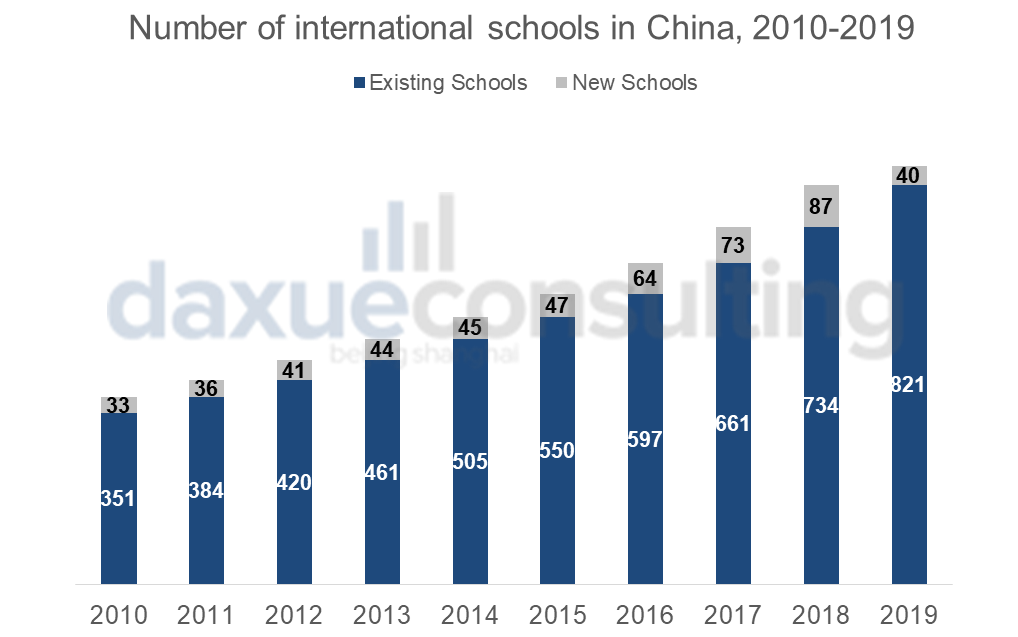
Source: Xinxueshuo, China’s International School Development report (2019), daxue consulting analysis, the number of international schools of China
The main reason behind this increased demand is more aspirational middle-class parents in China want a high-quality foreign education, which provides their children a greater opportunity of entering top universities.
Three types of international schools in China
International schools in China generally are divided into three categories: expatriate schools (15%), Chinese public schools (33%), and Chinese private schools (52%).
Expatriate schools (Expat schools), as the name implies, are for children of expatriates working in China. Usually, these schools are open to non-Chinese passport holders only, whether Chinese or foreign. However, the number of these schools has been reducing in recent years, because of strict regulations for enrollment qualifications and a decline in the growth of expatriates in China.
Some Chinese public schools provide international streams that teach bilingual education in China. These schools follow the Chinese curriculum but emphasize on English or other foreign languages.
Chinese private schools refer to joint ventures between a foreign education company or school and a local Chinese owner. 38 of 65 (58%) new international were private international schools, which is the rapid growth in China’s international education market. The admission targets local Chinese students and is open to any nationality as well. These schools offer an international curriculum and bilingual learning.
Government Regulations for International Schools in China
During the compulsory Chinese education years from Grade 1 to 9, all schools, with Chinese nationals students must follow the Chinese national curriculum, regardless of whether they are public or private. As international schools with under Grade 10 Chinese students, these schools had made adjustments to meet the government’s’ requirements as well as those parents’ needs, like extra-curricular courses.
After the compulsory years, international schools have the chance to set a western curriculum with students, so that students are able to take international examinations at age 18, such as A levels, AP (the Advanced Placement), and IB (International Baccalaureate Diploma), to get into western colleges.
China’s international education market is approaching saturation in the developed areas
Most international schools in China are established in first-tier cities or areas: Shanghai, Beijing, and Guangdong province. However, those local governments face education resource saturation, so many will have fewer school licenses in the future.
Nevertheless, in Guangdong province, thanks to the Outline Development Plan for the Guangdong-Hong kong-Macao Greater Bay Area, which aimed to develop international cooperation, more international education institutions are likely to be seen in this area.
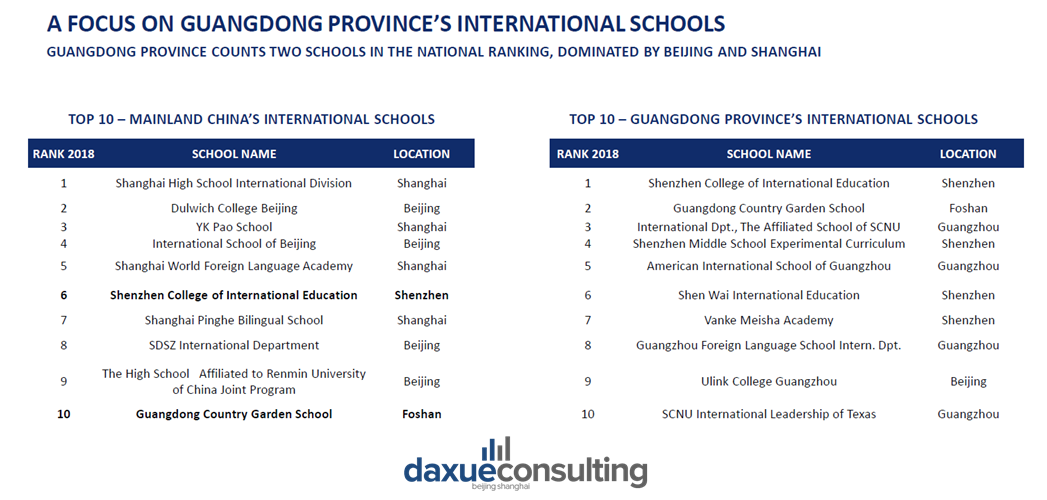
Source: Hurun, daxue consulting analysis, Top 10 International Schools in Mainland China and Guangdong Province
2nd and 3rd tier cities in the southwest of China are potential markets for private international schools in recent years, like Chengdu, Chongqing, and Xi’an. In 2019 alone, 8 new schools opened their doors for the first time in Sichuan province, only behind Guangdong and Jiangsu province.
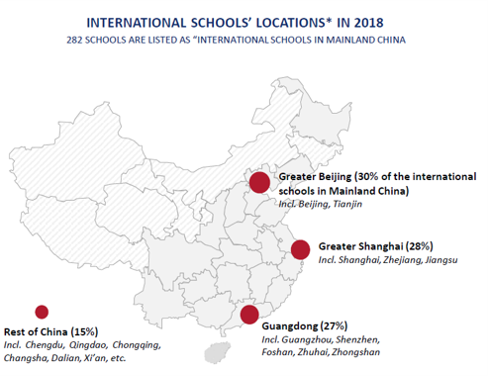
Source: ICS Research,daxue consulting analysis, daxue consulting analysis, International Schools’ Location in China (2018)
Parents’ attitude is the key to international schools in China
Besides expatriate children from foreign families, a large number of local Chinese children are attending international schools today. Chinese parents, particularly those who are middle-class with a highly-educated background, would like to invest in the children’s education in their best. In their opinion, international schools are regarded as stepping stones for getting into foreign excellent universities for their children. 30.7% of parents believe that high school is the best time to enter international schools, to get students ready for a foreign atmosphere which they may face later in life.
According to Hurun’s research, 83% of Chinese wealthy families see the “quality of education” for their children as the most important reason.
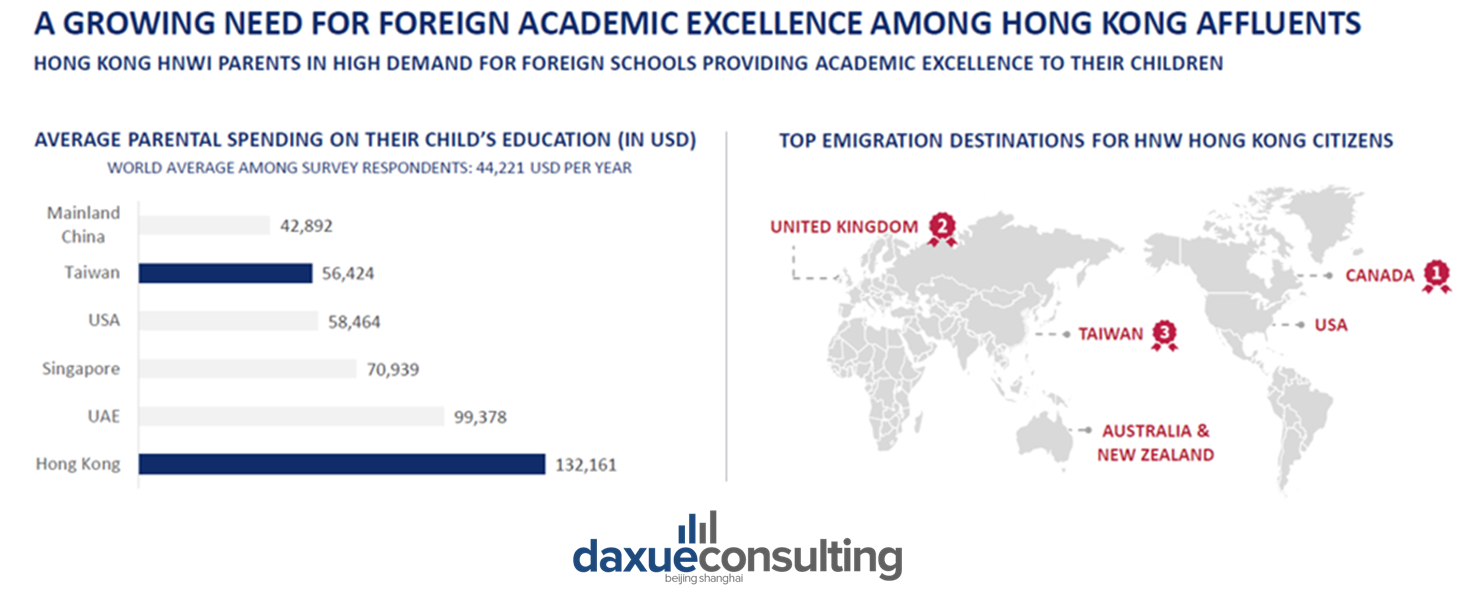
Source: HSBC, daxue consulting analysis, Average Parental Spending on Their Child’s Education; Forbes, Top Emigration Destinations for HNWI Hong Kong Citizens
Additionally, another motivation is to provide a better education environment for children. Generally, Chinese education emphasizes theoretical knowledge through textbooks and exams. The local school system is saturated with intense competition among peers. Some parents worry about the pressure of ruthless competition, often referring to the gaokao (Chinese college entrance exam), so they would prefer to provide their children with international education. International education often pays attention to comprehensive quality, such as the ability to think creatively and the cultivation of individual characteristics.
Opportunities and competitions in China’s international schools market
With the rapid expansion of international schools during the past decade, China’s international education market has begun to slow down. Also, along with the government’s tightening policy on China’s international education market, overall growth in 2019 was only 4.87%, compared with 11.85% in 2018 and 11.04% in 2017.
British independent schools
British independent schools have dominated China’s international education market for decades, with more new UK brands continuing to enter the market. The key to success is, they not only provided western curriculums and teaching methods, but align with the Chinese national curriculum requirements. Chinese parents want western education, but they also want to remain their own culture. Besides, one obvious advantage of British schools is, they bring a reputation and brand identity to the Chinese education market, responding to the demands of Chinese parents, with licensing, curriculum support, recruitment training as well as a reliable way to excellent higher education.
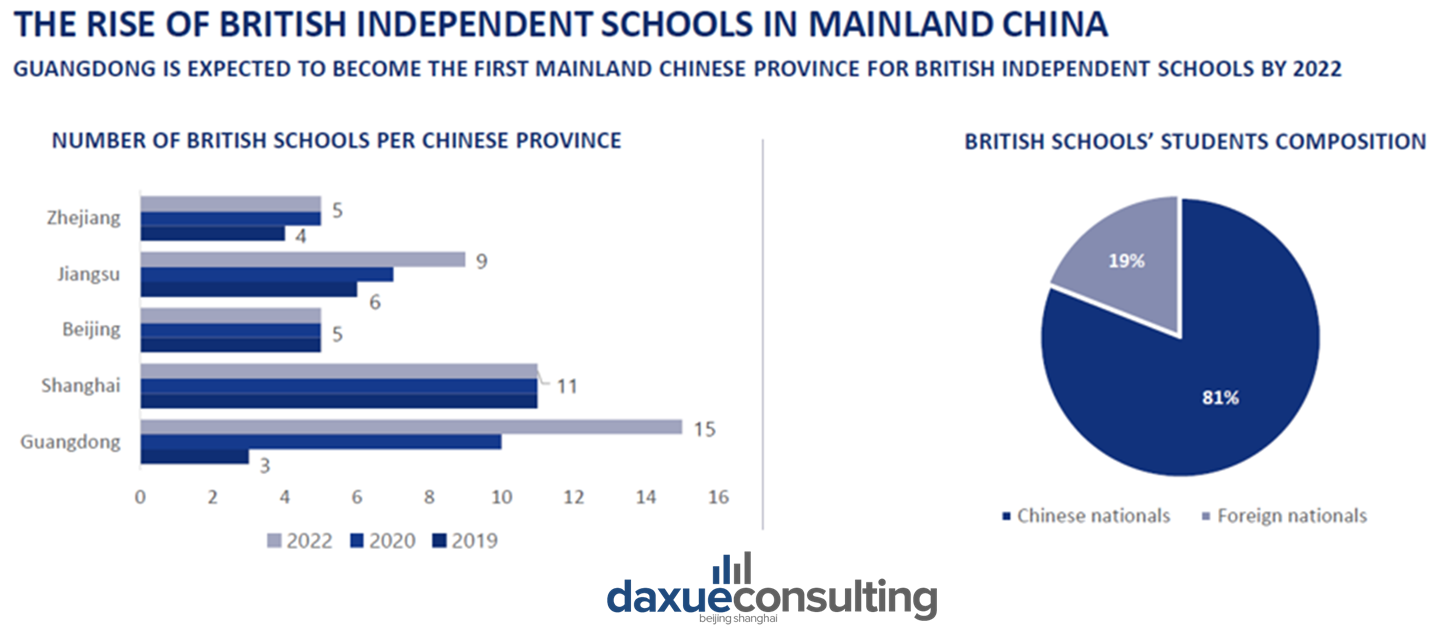
Source: Venture, Average Parental Spending on Their Child’s Education; Forbes, Top Emigration Destinations for HNWI Hong Kong Citizens British Independent Schools in China report (2020)
American schools
Different from British schools, American schools have lagged behind in the past years, partly due to the high emphasis on education brand reputation in the US education system. American schools focus more attention on education quality and carefully set up branch schools in China. However, more Chinese parents, students and employers have positive perceptions of the quality of US college education, and their demand for AP courses is also increasing. As a result, a growing number of US brands are entering the Chinese international schools market in recent years.
State-owned companies
However, competition is not only from private companies but also from state-owned companies. As China’s international education market becomes complicated and diverse, Chinese companies tend to establish their own brands. Financial Street Education Group, for example, established 2 new schools in the last year; and Country Garden, a Chinese property company, manages 7 international schools, one ranking 10th in top international schools in China, according to Hurun’s report. With the investment of local government, these companies have the confidence to make a profit in China’s international education market.
COVID-19’s Impact on China’s International Schools Market
COVID-19 affected the education industry globally, particularly in international education, arousing many challenges, but new opportunities as well.
Major examinations were canceled for spring and summer 2020; Many foreign teachers and students were unable to enter China due to the travel restrictions. Yet, China’s international schools reopened in September. According to a survey from the Association of China and Mongolia International Schools (ACAMIS) which includes 58 schools catering to mostly foreign children, up to 40% of teachers and students were still abroad in mid-September when the fall semester started.

Source: Siding Education, Empty Classroom in an International School during the Pandemic.
A number of international schools have provided online learning, which was relatively successful in teaching quality during the shutdown. Even though many schools admitted that they went back to in-person mode entirely after COVID-19, considering in-person classes were more effective in delivering course content, the online mode offered a new route for collaboration among all members of the school community. Especially for courses that only limited students attend, schools have the ability to gathering students and teachers around their sister schools via online rooms.
The future of China’s international schools market is growing with challenges
Data from QS showed, 66% of Chinese students said the coronavirus had significantly impacted their plans to study abroad, but only 4% of them no longer wanted to study overseas. Our COVID-19 impact survey of 400 Chinese students who study abroad, or plan to study abroad, showed that only a small percentage (2.6%) of those surveyed completely gave up their plans to study abroad.
However, the impact on students’ desire to work abroad was more severely impacted from COVID-19, which could in-turn, negatively impact the study abroad market which, down the line would decrease the need for international schools in China. Nonetheless, while these surveys serve as a snapshot of sentiment at a certain time, sentiment is subject to change as the world adjusts and overcomes the pandemic.
Most Chinese parents may be more cautious about the choice of country to study abroad; while some prefer to keep their children at home and send them to local international schools instead, in particular for parents who send kids overseas during the K-12 period.
On the one hand, Chinese parents’ demand for international schools is still stable before and after the coronavirus. On the other hand, international schools have to consider recruitment strategies for foreign teachers, in order to deal with a possible decline in their willingness to live in China after COVID-19, and stricter China visa policies while the virus is still actively spreading globally.
See how online education has boomed since COVID-19 in our stay-at-home economy report
Listen to over 100 China entrepreneur stories on China Paradigms, the China business podcast
Listen to China Paradigm on Apple Podcast






